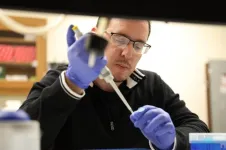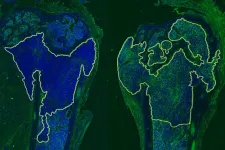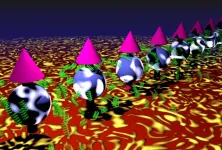(Press-News.org) PET, the plastic used to make bottles, for example, is ubiquitous in our natural environment. In a joint study, scientists from Leipzig University and the Helmholtz Centre for Environmental Research (UFZ) investigated the negative effects that tiny plastic PET particles can have on the metabolism and development of an organism. Their findings have now been published in the journal Scientific Reports.
The increasing use of plastic is threatening ecosystems around the world. One of the big concerns is the presence of plastics in the form of small particles, also called microplastics and nanoplastics. These particles have been detected in drinking water, food and even air. Nanoplastics can be absorbed by humans and animals through food as well as water. There are concerns that microplastics can accumulate in the body over time. Since their full effects on human health are still unknown, they are the subject of scientific research, as in the current study by Leipzig University.
Polyethylene terephthalate, known as PET, is a widely used plastic. It is used to make plastic bags as well as practical containers for food and drinks. Little is known so far about the damaging effects of PET nanoplastics. In a recently published research project, scientists at Leipzig University focused on the effects of PET nanoplastics on zebrafish embryos.
They found that the tiny plastic particles accumulated in several organs of the model animals, including the liver, intestine, kidney and brain. In addition, PET nanoplastics caused behavioural abnormalities in the embryos, as less movement was observed. “Our study provides the very first insight into the toxicity pathways induced by PET nanoplastics and the underlying damaging mechanisms in intact zebrafish larvae. We found that liver function was significantly impaired and that there was oxidative stress. PET nanoplastics also affect the cellular membrane and energetics of living organisms,” said corresponding author Dr Alia Matysik, a scientist at the Faculty of Medicine’s Institute of Medical Physics and Biophysics.
PET accumulation alters organism biochemistry
High-resolution magic-angle spinning (HRMAS), a non-invasive analytical technique that applies nuclear magnetic resonance (NMR) to solids and soft matter, was used to study zebrafish embryos. This scientific method has the advantage of being able to look into matter from the outside without, for example, having to damage tissue or insert instruments into the body. This study combined research on the metabolism of zebrafish cells and tissues, with cellular assays and behavioural tests. “We used state-of-the-art analytical NMR methods to obtain a comprehensive system-level understanding of the metabolic pathways affected by PET nanoplastics. We were able to observe how PET accumulation alters the biochemistry of an organism,” says Dr Matysik.
“This research finding highlights the adverse effects of PET nanoplastics, which have been observed in zebrafish embryos and may also play a role in mammals and humans. While we do not yet have a clear answer to this question, it is now safe to assume that PET nanoplastics are disrupting our ecosystems. In any case, plastics should be prevented from entering the environment. Presumably, avoiding this form of waste will be the big challenge of the near future,” says Professor Jörg Matysik from the Institute of Analytical Chemistry, who was involved in his wife’s study.
The scientists at Leipzig University plan to continue their research on this topic and also to investigate the effects of nanoplastics on brain function. “We’re already seeing PET nanoplastics accumulate in the brain. We now want to find out whether this has an impact on brain function and neurodegenerative diseases,” says Dr Alia Matysik.
END
How nanoplastics can influence metabolism
Researchers study effects of PET particles on zebrafish
2023-03-08
ELSE PRESS RELEASES FROM THIS DATE:
Virginia Tech researchers study PTSD effects on bystanders
2023-03-08
The traditional line of thought is that post-traumatic stress disorder (PTSD) is caused by directly experiencing the traumatic event. However, about 10 percent of diagnosed PTSD occurs when people witness these events versus experiencing it directly themselves.
Little is known about these cases of PTSD, but that’s something that Tim Jarome, an associate professor in the College of Agriculture and Life Sciences School of Animal Sciences, is aiming to change with a $430,000 grant from the National Institute ...
New pain medications are still widely inaccessible to individuals living with sickle cell disease
2023-03-08
(WASHINGTON, March 8, 2023) – Sickle cell disease (SCD), a rare chronic, progressive, life-threatening, inherited blood disorder, often affects individuals with chronic pain that can be debilitating to their quality of life. Yet less than 4% of people living with SCD who experience chronic pain episodes have prescriptions for newer FDA-approved pain-relieving drugs, including l-glutamine, voxelotor, and crizanlizumab, according to a new study published in Blood Advances. Further, researchers found that less than a third of patients with pain episodes have prescriptions for hydroxyurea, ...
Two-pronged immunotherapy eliminates metastatic breast cancer in mice
2023-03-08
Metastatic breast cancer has no cure and has proven stubbornly resistant to one of the most innovative and promising new cancer treatments: immunotherapy.
Now, researchers at Washington University School of Medicine in St. Louis have identified a way to treat the area surrounding breast tumors that have spread to bone so that such tumors become vulnerable to attack by the body’s immune system. When the researchers boosted the activity of certain immune cells, called T cells and macrophages, these immune cells worked together to clear metastatic breast tumors that had spread to the bones of mice, and continued to eliminate tumor cells ...
Researchers take a step towards turning interactions that normally ruin quantum information into a way of protecting it
2023-03-08
Researchers have found a way to predict the behavior of many-body quantum systems coupled to their environment. The work represents a way to protect quantum information in quantum devices, which is crucial for real-world applications of quantum technology.
In a study published in Physical Review Letters, researchers at Aalto University in Finland and IAS Tsinghua University in China report a new way to predict how quantum systems, such as groups of particles, behave when they are connected to the external environment. ...
Long-term exposure to nitrate in drinking water may be a risk factor for prostate cancer
2023-03-08
The nitrate ingested over the course of a person’s adult lifetime through the consumption of tap water and bottled water could be a risk factor for prostate cancer, particularly in the case of aggressive tumours and in younger men. This is the conclusion of a study conducted in Spain and led by the Barcelona Institute for Global Health (ISGlobal), a centre supported by the ”la Caixa” Foundation. The findings have been published in Environmental Health Perspectives.
The study also suggests that diet plays an important role. The researchers found that eating plenty of fibre, fruit/vegetables and vitamin C could reduce the negative effect ...
UNIST receives generous gift from BNK Kyongnam Bank
2023-03-08
UNIST and BNK Kyongnam Bank recently held a donation agreement ceremony in pursuit of creating a beautiful, biodiverse, and sustainable kitchen garden on UNIST campus.
A ceremony to commemorate and display gratitude for BNK Kyongnam Bank also took place on Friday, February 24, 2023. As part of its Carbon Neutral Campus Project, UNIST has been implementing a number of projects to improve sustainability on campus and in the surrounding community, including the creation of an ecological garden that ...
Seeking leukemia’s Achilles heel
2023-03-08
A team of researchers has discovered a potential therapeutic that can synergize with existing drugs to more effectively kill certain leukemia cells. The authors published their results on Jan. 19 in the journal Molecular & Cellular Proteomics.
Acute myeloid leukemia is a cancer of developing immune cells. It can manifest in all individuals, including the elderly and children. Only 30% of patients survive beyond five years of diagnosis
Unlike cancers of solid organs, AML is found in bodily fluids, such as blood. Like passengers ...
Men over 65 are at greater risk than women of skull fractures from falls
2023-03-08
Each year, more than 3 million people ages 65 and older are treated in emergency departments for fall injuries. Head trauma is the leading cause of serious injury with skull fractures being reported as a serious outcome. According to the 2016 National Trauma Database annual report, females account for 58 percent of these falls.
Because geriatric females have an increased rate of falls and facial fractures, determining if they also are at an increased risk of skull fractures is crucial. Currently, research ...
Highlight facts or appeal to feelings? The psychology of persuading individuals to contribute to a collective goal
2023-03-08
Researchers from Fudan University, China Europe International Business School, and Peking University published a new Journal of Marketing article that examines how marketers can use different messaging to persuade individuals to contribute to a collective goal. The study addresses the specific question of the type of message—fact-based vs. affected-based—that is more effective in eliciting participation based on how near the goal is to completion.
The study, forthcoming in the Journal ...
Just add water: How diluting ouzo liquor could lead to better emulsions
2023-03-08
It sounds like a party trick: Add water to the clear, licorice-flavored ouzo liquor, and watch it turn cloudy. This “ouzo effect” is an example of an easy way to make highly stable emulsions — or mixtures of liquids that don’t like being together, like vinaigrettes — but nobody has yet fully understood how it works. Now, researchers report in ACS Central Science that the secret may lie in the unique structure of the emulsion’s droplets.
Ouzo is a popular liquor enjoyed throughout Greece, ...
LAST 30 PRESS RELEASES:
Making lighter work of calculating fluid and heat flow
Normalizing blood sugar can halve heart attack risk
Lowering blood sugar cuts heart attack risk in people with prediabetes
Study links genetic variants to risk of blinding eye disease in premature infants
Non-opioid ‘pain sponge’ therapy halts cartilage degeneration and relieves chronic pain
AI can pick up cultural values by mimicking how kids learn
China’s ecological redlines offer fast track to 30 x 30 global conservation goal
Invisible indoor threats: emerging household contaminants and their growing risks to human health
Adding antibody treatment to chemo boosts outcomes for children with rare cancer
Germline pathogenic variants among women without a history of breast cancer
Tanning beds triple melanoma risk, potentially causing broad DNA damage
Unique bond identified as key to viral infection speed
Indoor tanning makes youthful skin much older on a genetic level
Mouse model sheds new light on the causes and potential solutions to human GI problems linked to muscular dystrophy
The Journal of Nuclear Medicine ahead-of-print tip sheet: December 12, 2025
Smarter tools for peering into the microscopic world
Applications open for funding to conduct research in the Kinsey Institute archives
Global measure underestimates the severity of food insecurity
Child survivors of critical illness are missing out on timely follow up care
Risk-based vs annual breast cancer screening / the WISDOM randomized clinical trial
University of Toronto launches Electric Vehicle Innovation Ontario to accelerate advanced EV technologies and build Canada’s innovation advantage
Early relapse predicts poor outcomes in aggressive blood cancer
American College of Lifestyle Medicine applauds two CMS models aligned with lifestyle medicine practice and reimbursement
Clinical trial finds cannabis use not a barrier to quitting nicotine vaping
Supplemental nutrition assistance program policies and food insecurity
Switching immune cells to “night mode” could limit damage after a heart attack, study suggests
URI-based Global RIghts Project report spotlights continued troubling trends in worldwide inhumane treatment
Neutrophils are less aggressive at night, explaining why nighttime heart attacks cause less damage than daytime events
Menopausal hormone therapy may not pose breast cancer risk for women with BRCA mutations
Mobile health tool may improve quality of life for adolescent and young adult breast cancer survivors
[Press-News.org] How nanoplastics can influence metabolismResearchers study effects of PET particles on zebrafish




